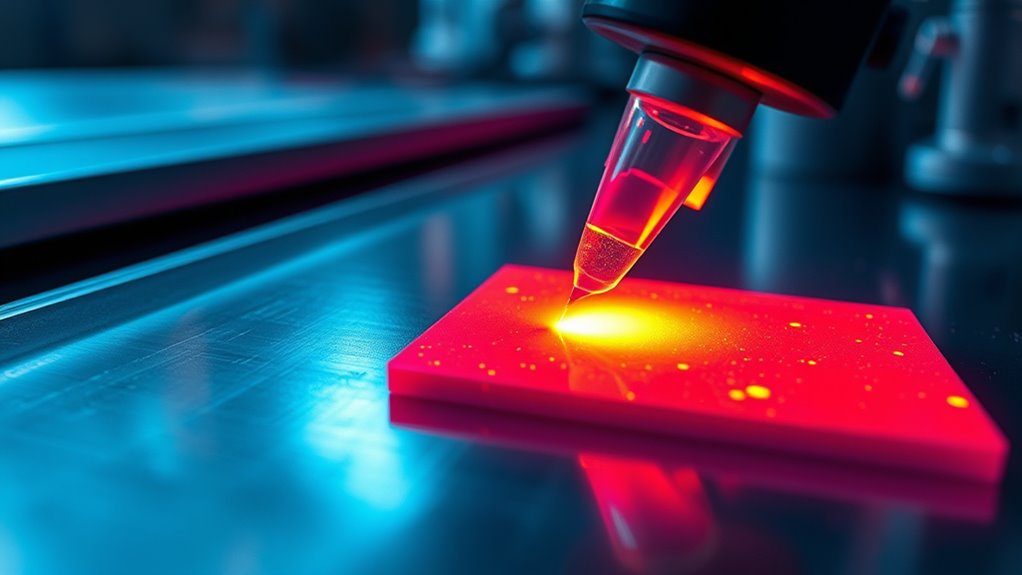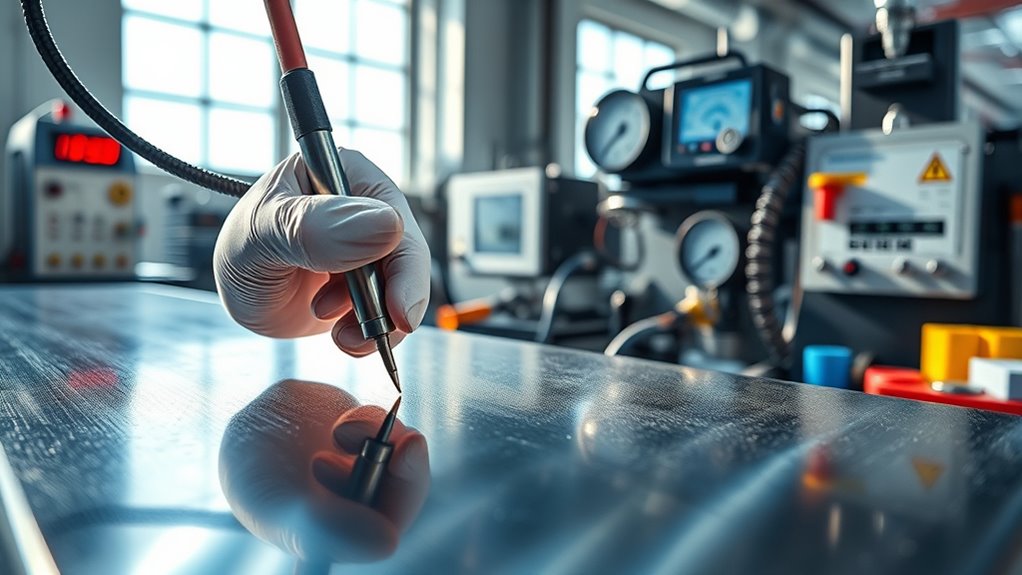Many believe heat tolerant adhesives can handle unlimited high temperatures, but that’s a myth. In reality, their strength depends on formulation, application, and conditions. Some adhesives only withstand brief heat spikes, while others are designed for long-term exposure. Knowing the difference between heat tolerance and resistance helps you choose the right product. If you want to avoid failures and get durable bonds, understanding these facts can make all the difference—discover more below.
Key Takeaways
- Heat tolerant adhesives can withstand high temperatures but are not suitable for unlimited heat exposure.
- Proper formulation and additives are essential for an adhesive’s heat resistance and durability.
- Heat tolerance relates to brief temperature spikes, while heat resistance means long-term stability under heat.
- Many adhesives weaken or fail under high heat, contrary to common misconceptions of universal heat handling.
- Choosing the right adhesive depends on the specific temperature, duration, and material compatibility for the application.
What Are Heat Tolerant Adhesives and How Do They Work?

Heat tolerant adhesives are specially formulated glues designed to withstand high temperatures without losing their bonding strength. They are engineered to accommodate thermal expansion, which occurs when materials expand or contract due to temperature changes. These adhesives are designed to maintain their integrity during repeated heating and cooling cycles. When you apply heat tolerant adhesive, proper adhesive curing is essential for reliable performance. During curing, the adhesive undergoes a chemical process that bonds it securely to surfaces, forming a strong, durable connection. This process ensures the adhesive can handle extreme heat without degrading or losing adhesion. Additionally, understanding how HEPA filters work can help in selecting adhesives that won’t be affected by the fine particles they filter out. By understanding how thermal expansion affects materials and ensuring correct curing, you can select the right heat tolerant adhesive for demanding environments.
Common Misconceptions About Heat Resistance in Adhesives

Many people believe that heat resistance means adhesives can handle any temperature without issue, but that’s not true. Not all adhesives are built to withstand high heat, and their performance can vary greatly. Understanding these misconceptions helps you choose the right adhesive for your specific needs. For example, some adhesives may be suitable for light applications but fail in high-temperature environments such as near a home theatre projector or in electronic device assembly, where heat resistance is critical.
Heat Resistance Is Absolute
While some believe that heat-resistant adhesives can withstand any temperature without degradation, this is a common misconception. No adhesive is truly immune to heat; instead, they have specific limits. When exposed to high temperatures, materials can experience thermal expansion, causing stress at the bond line. Even heat-tolerant adhesives have a maximum temperature where their adhesive viscosity starts to change, weakening the bond. Beyond that point, the adhesive may become too fluid or brittle, reducing its effectiveness. Assuming absolute heat resistance ignores these limits, leading to failures in real-world applications. Always check the manufacturer’s specifications and understand that every adhesive has a threshold, no matter how high it seems. Thermal stability is a crucial factor in adhesive selection, as it directly impacts performance under heat exposure. No adhesive can handle unlimited heat without eventual degradation.
All Adhesives Handle Heat
Although it’s common to assume all adhesives can withstand high temperatures, this isn’t true. Not every adhesive has the same durability under heat. Many people overlook temperature limitations, believing adhesives are universally heat-resistant. In reality, some adhesives weaken or fail when exposed to heat, affecting their adhesive durability. To clarify, here’s a quick comparison:
| Adhesive Type | Max Temperature | Common Uses |
|---|---|---|
| Epoxy | 150°C | Structural bonding |
| Hot Glue | 80°C | Crafts, minor repairs |
| Polyurethane | 90°C | Heavy-duty applications |
Knowing these limits helps you choose the right adhesive for heat-sensitive projects and avoid costly failures.
The Difference Between Heat Tolerance and Heat Resistance

Understanding the difference between heat tolerance and heat resistance helps you choose the right adhesive for your needs. Heat tolerance refers to how much heat an adhesive can handle without failure, while heat resistance indicates its ability to withstand prolonged exposure. Recognizing these distinctions affects material performance and guides you in selecting adhesives suited for specific practical applications. Additionally, factors such as chemical composition and formulation can influence an adhesive’s overall performance under heat.
Definition Clarification Needed
Many people confuse heat tolerance with heat resistance when evaluating adhesives, but they actually refer to different qualities. Heat tolerance refers to an adhesive’s ability to endure high temperatures without losing its bonding strength, often involving issues like thermal expansion. Heat resistance, on the other hand, is about how well an adhesive withstands prolonged exposure to heat without degrading. To clarify:
- Heat tolerance allows for temperature fluctuations during adhesive bonding.
- Heat resistance ensures long-term stability at high temperatures.
- Thermal expansion may cause stress on bonds if the adhesive isn’t heat tolerant.
- Heat resistance is essential for applications exposed to consistent high heat over time.
Understanding these differences helps you choose the right adhesive for your specific needs, especially when dealing with thermal expansion challenges.
Material Performance Differences
When selecting adhesives for high-temperature applications, recognizing the differences between heat tolerance and heat resistance is essential for optimal material performance. Heat tolerance refers to an adhesive’s ability to withstand brief temperature spikes without failing, while heat resistance indicates how well it performs over sustained high temperatures. Material flexibility plays a role, as some adhesives maintain elasticity even under heat, preventing cracking or delamination. Aesthetic considerations also matter—certain heat-resistant adhesives may alter appearance or require specific surface finishes. Understanding these distinctions helps you choose the right adhesive for your project’s needs, ensuring durability without compromising flexibility or visual appeal. By knowing whether your application demands quick heat adaptability or long-term resistance, you’ll achieve better results and longer-lasting bonds. Additionally, awareness of different hackathon types can inspire innovative approaches to developing advanced adhesive solutions suitable for various high-temperature environments.
Practical Application Variations
Choosing the right adhesive depends on whether your application demands quick heat tolerance or long-term heat resistance. Different application scenarios require different strategies aligned with industry standards. For example:
- Use heat-tolerant adhesives for short-term tasks like assembly lines where quick bonding is needed.
- Opt for heat-resistant adhesives in applications like aerospace, where long-term exposure to high temperatures is common.
- Consider industry standards when selecting adhesives, ensuring they meet safety and durability requirements.
- Evaluate whether your scenario involves frequent temperature fluctuations or sustained heat, influencing your choice.
- Incorporating vertical storage solutions can help organize materials and accessories related to adhesive applications, ensuring easy access and safety during projects.
Factors That Affect an Adhesive’s Heat Tolerance

The heat tolerance of an adhesive depends on several key factors that influence how well it performs under high temperatures. One major factor is chemical interactions, which determine how the adhesive’s molecules respond when heated. Strong chemical bonds can withstand higher temperatures without breaking down. Another critical aspect is thermal expansion; if the adhesive and substrate expand at different rates, it can cause stress and weaken the bond. The formulation of the adhesive also matters—certain ingredients improve heat resistance by enhancing stability. Additionally, the presence of fillers or additives can bolster the adhesive’s ability to handle heat. Understanding these factors helps you select or design adhesives that maintain their integrity and bond strength in demanding, high-temperature environments.
Types of Adhesives Suitable for High-Temperature Applications

Certain adhesives are specifically formulated to perform reliably in high-temperature environments, making them essential for applications like aerospace, automotive, and industrial manufacturing. When selecting high temp glues, consider these options:
- Silicone-based adhesives offer excellent thermal bonding and flexibility at elevated temperatures.
- Epoxy resins provide strong, durable bonds suitable for high-stress, high-heat conditions.
- Polyimide adhesives excel in extreme heat, often used in aerospace applications.
- Phenolic adhesives are resistant to heat and chemicals, making them ideal for industrial uses.
These adhesives are designed to withstand intense heat without losing their bonding strength, ensuring safety and reliability in demanding environments. Choosing the right high temp glues depends on your specific application’s temperature range and material compatibility. Understanding the properties of high-temperature adhesives can help you select the best option for your needs.
How to Choose the Right Heat Tolerant Adhesive for Your Project

Selecting the right heat-tolerant adhesive depends on understanding your project’s specific requirements, including the maximum temperature it will face, the materials involved, and the environmental conditions. When making your adhesive selection, consider whether the adhesive must withstand continuous high heat or brief exposures. Think about the materials you’re bonding—metals, plastics, or ceramics—as different adhesives perform better with certain substrates. Also, evaluate environmental factors like moisture, vibration, or chemical exposure, which can affect adhesive performance. By carefully analyzing these project considerations, you can choose an adhesive that offers reliable heat resistance and durable bonding. Proper selection guarantees your project stays intact under high temperatures, avoiding costly failures or repairs later.
Tips for Applying and Testing Heat Tolerant Adhesives

Applying heat-tolerant adhesives correctly is essential to guaranteeing a strong, durable bond that withstands high temperatures. Proper application techniques and thorough adhesive testing are key. First, prepare surfaces by cleaning and roughening them for better adhesion. Second, follow the manufacturer’s instructions for applying the right amount of adhesive. Third, clamp or hold surfaces firmly during curing to ensure even bonding. Fourth, test the adhesive’s heat resistance after curing by exposing it to simulated high temperatures. This adhesive testing confirms the bond’s strength under operational conditions. Always use appropriate tools and techniques for application, and don’t skip the testing phase. Ensuring the adhesive remains stable over time can be supported by understanding the expiration of vape juice, as improper storage conditions may affect adhesive longevity. Correct application and validation ensure your heat-tolerant adhesive performs reliably even in extreme heat.
Frequently Asked Questions
Can Heat Tolerant Adhesives Be Used Underwater or in Wet Conditions?
Yes, heat tolerant adhesives can be used underwater and in wet conditions, especially for marine applications. They’re designed to bond underwater effectively, resisting moisture and temperature fluctuations. When choosing an adhesive for bonding underwater, verify it’s specifically rated for marine use and wet environments. This way, you get reliable, durable bonds that withstand the challenges of aquatic settings, making your projects more successful and long-lasting.
How Long Can Heat Tolerant Adhesives Withstand High Temperatures?
Imagine a superhero with thermal endurance—your adhesive can withstand high temperatures for hours, sometimes even days. Typically, heat tolerant adhesives endure temperatures up to 500°F (260°C), but some specialized formulas reach even higher. The key is understanding their temperature limits; most are designed for sustained use at specific high temps. Always check the product’s specifications, knowing that exceeding these limits may compromise adhesion or cause failure over time.
Are There Environmental Concerns With Using Heat Resistant Adhesives?
Yes, using heat resistant adhesives can raise environmental impact and sustainability concerns. These adhesives often contain chemicals that may be harmful if not properly managed, potentially contaminating soil and water. Additionally, their production can consume significant energy, contributing to carbon emissions. To minimize these issues, opt for eco-friendly, biodegradable options when available, and follow disposal guidelines carefully to reduce your environmental footprint.
Do Heat Tolerant Adhesives Emit Harmful Fumes During Curing?
Think of curing heat-tolerant adhesives like a secret handshake—you want to keep it safe. During curing, some fume emissions may occur, but reputable brands design them to minimize harmful fumes. Always guarantee proper curing safety by working in well-ventilated areas and following manufacturer instructions. This way, you protect yourself from unnecessary exposure and enjoy the benefits of heat-resistant bonds without risking health.
Can Heat Resistant Adhesives Be Removed or Replaced Easily?
Yes, heat resistant adhesives can be removed or replaced, but the process varies. Typically, you’ll need to soften the adhesive with heat or solvents to loosen it. The removal process can be straightforward or challenging depending on the surface and adhesive type. Once removed, you have several replacement options, including applying a fresh layer of heat resistant adhesive or choosing a different product suited to your needs.
Conclusion
Understanding heat tolerant adhesives helps you make smarter choices for high-temperature projects. Did you know that the global adhesive market is expected to reach $84 billion by 2025? By debunking myths and knowing the facts, you can select the right adhesive that withstands extreme heat without failing. Remember, proper application and testing are key to ensuring long-lasting results. Stay informed, choose wisely, and your projects will hold up even under the hottest conditions.









